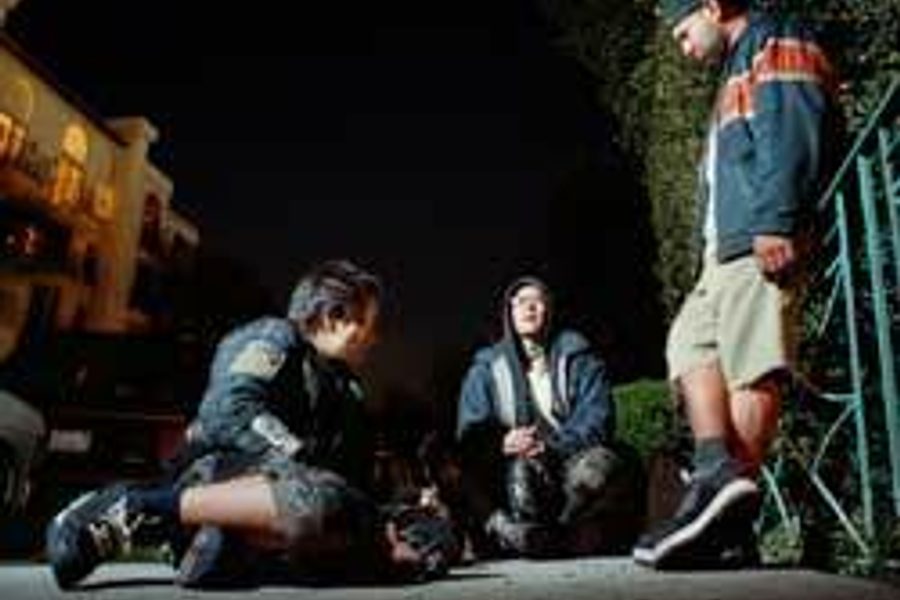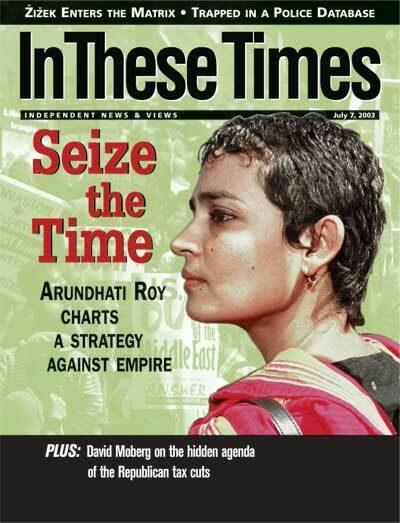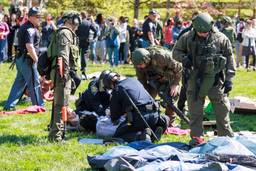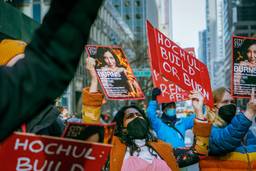
In downtown Los Angeles, Ruben is enduring his freedom. At 23, Ruben wants job training, education, and a chance to elevate himself. But like 300,000 youth in California and hundreds of thousands of others across the nation, Ruben (whose name has been changed to protect his identity) is identified in state and local law enforcement databases as a gang member. The databases are part of a wide-ranging effort to identify and target gang members for enhanced criminal sentencing.
Under California’s Street Terrorism Enforcement and Protection (STEP) Act, enacted in 1988, gangs are considered to “threaten, terrorize, and commit a multitude of crimes against … peaceful citizens.” Indeed, gangs are a problem. In 2001, the Los Angeles Sheriff’s Department recorded 587 gan-related homicides in Los Angeles County.The act provides stiff penalties for gang activity on the principle that “whenever you commit a crime, you are doing so for the gang,” says Alejandro Alonso, a Los Angeles gangs expert and creator of the Web site www.streetgangs.com. As such, individuals entered in the gang database can be subject to enhanced sentencing. The minimum enhancement is six months, but some crimes carry as much as 15 years.
Ruben says he found this out “the hard way.” In 1993, Ruben was with his older cousin, a known gang member, when the cousin was stopped by police. “Since I was with him, they asked me a bunch of questions … and took a picture of me,” he says. He was 13.
Five years later he was charged with assault for being involved in a street fight. “I’m in court, and the prosecutor is trying to put gang enhancements on me because he says I’m in this gang file,” Ruben says. “I’m like, what? Gang file? That was the first I had heard of it.” He shakes his head. “And now I can’t get off the list. I asked my public defender to help, but he just waved his hand, like, ‘Whatever.’ The judge wouldn’t let me talk.”
As the war on terrorism continues, Ruben looks at federal anti-terrorism laws like the USA Patriot Act and worries that his presence in the gang database makes him vulnerable. “In California, they already call gangs ‘terrorists,’” he says. “What’s going to come next?”
————–
The criteria as to what constitutes a gang member varies from jurisdiction to jurisdiction, but the pattern is generally the same. Police can stop and question individuals on the street either as part of an arrest or under the “common law right to inquire”—an amorphous legal principle which, as determined by case law, is interpreted to mean that a police officer may stop and speak to a person as long as that person is free to ignore the inquiry (the idea being that such an inquiry does not fall under the category of a search and seizure). However, many people don’t realize they are free to refuse to answer questions.
Police officers use the “right to inquire” to stop an individual they believe to be a gang member, ask them questions, take note of their dress—checking for identifying markings such as tattoos —and search them. “The cops can basically make a person strip in the street if they want,” says Kim McGill of the Youth Justice Coalition, a nonprofit group working to reform the databases. “They can stop you regardless of your age, regardless of whether you are with your parents or not. They can ask you where you live, who you hang with, what nicknames you may have. Based on how you answer those questions, the cops can assume you are in a gang and put you in that gang database.”
Don Lyddane, an investigator with the FBI’s Safe Streets and Gang Unit, defends these databases. The practices are intelligence databases assembled in accordance with the STEP Act, Lyddane says, and just part and parcel of good detective work. “Gang members are, by definition, involved in criminal activity,” he argues. “So it’s not like these databases are keeping tabs on your good citizens down the street. Having these databases allows you to manage information, anticipate who may commit crimes, and track down suspects quicker and easier.”
The database was originally developed by the Los Angeles Sheriff’s Department in the mid-’70s, when Latino gangs were widespread in Los Angeles and the Crips and Bloods were on the rise. The system, designed and implemented by Detective Wes McBride, now retired, and his staff, served as a model for California and the rest of the nation. Now, numerous states, including Florida, Illinois, Texas, Virginia, and the District of Columbia, maintain and use gang databases.
Under McBride’s system, as he describes it, officers must undergo training at a school for gang officers. They must then make their decision about whether someone is in a gang by judging them against two to nine potential criteria. The officer submits this information to a supervisor, who confirms the decision to label someone as a gang member. “There’s no doubt the databases are useful if you are a police officer,” Alonso says. “The database can put a lot of different investigative tools at your disposal.”
The problem is that the tools are not always sharp or precise. “What you see is people who don’t consider themselves gang members being put on the database because of their associations,” Alonso says. “Then, from a legal standpoint, … if you ever get picked up for a crime, the presumption is going to be that whatever you did, you did for the gang, and there will be extra penalties.”
Lyddane thinks these concerns are overblown. In order to add a name to a gang database, Lyddane says, “There has to be some sort of criminal nexus. I don’t know of any cop or jurisdiction that identifies someone as a gang member based solely on baggy clothes.”
But he concedes that the criteria for identifying someone as a gang member are flexible. “You aren’t looking to establish [gang affiliation] beyond a reasonable doubt,” he says, “but rather to identify someone as a gang member, according to a specific set of criteria, for intelligence gathering purposes.”
————–
McGill and other opponents of gang databases are not so sanguine, given the questions surrounding the databases’ precision and accuracy. “If you use their criteria,” Alonso says, “you could enter just about anybody into the database.”
“I’ve seen estimates that as high as 50 to 80 percent of the information in these databases is inaccurate [or] erroneous,” says Carol Sobel, senior staff attorney for the ACLU. One Los Angeles Sheriff’s Department officer contacted for this story confirmed the low end of those estimates. Lyddane acknowledges problems in certain localities. “But on the whole,” he says, “in most jurisdictions, law enforcement officers are very careful about who they choose to include in those databases.”
One would hope so, given that the only way to get off the list is to be free from police contact for five years, even if you shouldn’t have been put on in the first place. “That’s not just free from arrest,” Alonso says. “That’s five years without coming into contact with the police at all. Not even a traffic stop.”
How likely is it that a person of color in the inner city can go five years without being stopped by a police officer?
Even in Los Angeles—a county whose system for identifying gang members Lyddane says is “one of the best”—mistakes are made. Ed is a skinny 16-year-old (his name has been changed) just out of East Lake Juvenile Hall, where he was serving a sentence for vandalism. He’s an admitted graffiti artist, but denies any gang affiliation. And like Ruben, he was added to the database because he got stopped walking with his older brother. “When I got out of East Lake, I was supposed to just be on regular probation,” Ed says. “But when I sat down and talked to my probation officer, he said that since I was in a gang, there were going to be 11 new conditions to my probation.”
Among them: Ed cannot wear baggy clothes or a jersey with the number 13 on it. He cannot shave his head, and must avoid certain areas of the city. He also cannot associate with any known or suspected gang members—including his brother. Ed says: “I was like, ‘But I’m not in a gang,’ and [the officer] was like, ‘Yes you are,’ and he tossed these Polaroids that the cops had taken of me and my brother. I told him that it was my brother, but it didn’t make a difference.”
Police are not required to inform anyone, minor or adult, whether they’ve been placed on the list, so people like Ruben and Ed have no way to find out if they are on the database, short of being arrested. “The only way we can find out is through undercover sources in the police department,” McGill says.
“Even if you get off in a five-year purge,” Sobel adds, “you can’t be sure, because no one is monitoring it.”
Ed says he tried to have his name taken off the database—his parents even visited the station to make an appeal—but police didn’t respond. “I think I’m still on there,” he says, “but I can’t find out, ’cause when I call the police they won’t give me that information. They say they are protecting my privacy.”
Sobel says the ACLU has made challenges to the language and spirit of the STEP Act, but that the challenges have been largely unsuccessful. “The courts have, in effect, said that no, the language in the law is not too vague,” she says. “We have had some success on a case by case basis by challenging specific incidences where people have been wrongly put on the database, but because there is no published database, … it’s difficult to mount a comprehensive challenge to the law.”
————–
The civil rights issues surrounding gang databases would be alarming at any time. But with the Justice Department’s push to gather more and more information under the rubric of the war on terrorism, the issue’s salience moves front and center. The domestic terrorism provisions of the USA Patriot Act “could likely be applied to street gang members, the way that it could be applied to environmental groups,” Sobel says.
“One of the things we’ve seen in this administration’s so-called war on terror is that, in order to secure the cooperation of countries with our program, we are agreeing to classify groups that are troublesome in their countries as ‘terrorist groups,’ whether they are or not,” she continues. “Many gang members in this country are also nationals of another country, and many have contact with individuals who are associated with alleged terrorist group[s]. Under the Patriot Act, those people are terrorists, as are the people they associate with.”
In fact, gang members are conveniently listed in a database already. “They call it the Department of Homeland Security, but down here they should just call it the Department of Homeboy Security,” Sobel says.
If there is a silver lining for gang database opponents, it’s that existing efforts to consolidate gang information into a comprehensive national database have been hobbled by infighting. “There’s been attempts to bring all these databases together,” says McBride. “But they haven’t been really successful because [local law enforcement] doesn’t want the Feds to control their data, and vice versa.” Lyddane echoes this sentiment. “Realistically, I don’t think a national database is going to be implemented anytime soon. I think we’ll probably stay with the status quo.”
As for reforms, Lyddane and McBride don’t think they are necessary. “These databases are designed to ensure that we have as low a level of error as we can,” Lyddane says.
But opponents like McGill and Sobel want to see a greater level of transparency and accountability in the databases. “Instead of five years without any police contact,” says McGill, “that should be more like 18 months.” And then there are questions of due process and the constitutional right to be presumed innocent. “The burden of proof should lie with law enforcement,” says Sobel. “It should be their responsibility to prove that someone is in a gang. You shouldn’t ever have to prove that you are not.”
But until those reforms are realized, people like Ed and Ruben have to watch their backs. “You gotta make sure you got everything right,” Ruben says. “’Cause these cops will stop you and look for some reason to bust your ass. You can’t be bald, or wear certain clothes, or even see your family or your baby’s mama if they are gang members. ’Cause if you do, they’ll get you. They’re watching, and they’ll get you one way or another.”
Under California’s Street Terrorism Enforcement and Protection (STEP) Act, enacted in 1988, gangs are considered to “threaten, terrorize, and commit a multitude of crimes against … peaceful citizens.” Indeed, gangs are a problem. In 2001, the Los Angeles Sheriff’s Department recorded 587 gan-related homicides in Los Angeles County.The act provides stiff penalties for gang activity on the principle that “whenever you commit a crime, you are doing so for the gang,” says Alejandro Alonso, a Los Angeles gangs expert and creator of the Web site www.streetgangs.com. As such, individuals entered in the gang database can be subject to enhanced sentencing. The minimum enhancement is six months, but some crimes carry as much as 15 years.
Ruben says he found this out “the hard way.” In 1993, Ruben was with his older cousin, a known gang member, when the cousin was stopped by police. “Since I was with him, they asked me a bunch of questions … and took a picture of me,” he says. He was 13.
Five years later he was charged with assault for being involved in a street fight. “I’m in court, and the prosecutor is trying to put gang enhancements on me because he says I’m in this gang file,” Ruben says. “I’m like, what? Gang file? That was the first I had heard of it.” He shakes his head. “And now I can’t get off the list. I asked my public defender to help, but he just waved his hand, like, ‘Whatever.’ The judge wouldn’t let me talk.”
As the war on terrorism continues, Ruben looks at federal anti-terrorism laws like the USA Patriot Act and worries that his presence in the gang database makes him vulnerable. “In California, they already call gangs ‘terrorists,’” he says. “What’s going to come next?”
————–
The criteria as to what constitutes a gang member varies from jurisdiction to jurisdiction, but the pattern is generally the same. Police can stop and question individuals on the street either as part of an arrest or under the “common law right to inquire”—an amorphous legal principle which, as determined by case law, is interpreted to mean that a police officer may stop and speak to a person as long as that person is free to ignore the inquiry (the idea being that such an inquiry does not fall under the category of a search and seizure). However, many people don’t realize they are free to refuse to answer questions.
Police officers use the “right to inquire” to stop an individual they believe to be a gang member, ask them questions, take note of their dress—checking for identifying markings such as tattoos —and search them. “The cops can basically make a person strip in the street if they want,” says Kim McGill of the Youth Justice Coalition, a nonprofit group working to reform the databases. “They can stop you regardless of your age, regardless of whether you are with your parents or not. They can ask you where you live, who you hang with, what nicknames you may have. Based on how you answer those questions, the cops can assume you are in a gang and put you in that gang database.”
Don Lyddane, an investigator with the FBI’s Safe Streets and Gang Unit, defends these databases. The practices are intelligence databases assembled in accordance with the STEP Act, Lyddane says, and just part and parcel of good detective work. “Gang members are, by definition, involved in criminal activity,” he argues. “So it’s not like these databases are keeping tabs on your good citizens down the street. Having these databases allows you to manage information, anticipate who may commit crimes, and track down suspects quicker and easier.”
The database was originally developed by the Los Angeles Sheriff’s Department in the mid-’70s, when Latino gangs were widespread in Los Angeles and the Crips and Bloods were on the rise. The system, designed and implemented by Detective Wes McBride, now retired, and his staff, served as a model for California and the rest of the nation. Now, numerous states, including Florida, Illinois, Texas, Virginia, and the District of Columbia, maintain and use gang databases.
Under McBride’s system, as he describes it, officers must undergo training at a school for gang officers. They must then make their decision about whether someone is in a gang by judging them against two to nine potential criteria. The officer submits this information to a supervisor, who confirms the decision to label someone as a gang member. “There’s no doubt the databases are useful if you are a police officer,” Alonso says. “The database can put a lot of different investigative tools at your disposal.”
The problem is that the tools are not always sharp or precise. “What you see is people who don’t consider themselves gang members being put on the database because of their associations,” Alonso says. “Then, from a legal standpoint, … if you ever get picked up for a crime, the presumption is going to be that whatever you did, you did for the gang, and there will be extra penalties.”
Lyddane thinks these concerns are overblown. In order to add a name to a gang database, Lyddane says, “There has to be some sort of criminal nexus. I don’t know of any cop or jurisdiction that identifies someone as a gang member based solely on baggy clothes.”
But he concedes that the criteria for identifying someone as a gang member are flexible. “You aren’t looking to establish [gang affiliation] beyond a reasonable doubt,” he says, “but rather to identify someone as a gang member, according to a specific set of criteria, for intelligence gathering purposes.”
————–
McGill and other opponents of gang databases are not so sanguine, given the questions surrounding the databases’ precision and accuracy. “If you use their criteria,” Alonso says, “you could enter just about anybody into the database.”
“I’ve seen estimates that as high as 50 to 80 percent of the information in these databases is inaccurate [or] erroneous,” says Carol Sobel, senior staff attorney for the ACLU. One Los Angeles Sheriff’s Department officer contacted for this story confirmed the low end of those estimates. Lyddane acknowledges problems in certain localities. “But on the whole,” he says, “in most jurisdictions, law enforcement officers are very careful about who they choose to include in those databases.”
One would hope so, given that the only way to get off the list is to be free from police contact for five years, even if you shouldn’t have been put on in the first place. “That’s not just free from arrest,” Alonso says. “That’s five years without coming into contact with the police at all. Not even a traffic stop.”
How likely is it that a person of color in the inner city can go five years without being stopped by a police officer?
Even in Los Angeles—a county whose system for identifying gang members Lyddane says is “one of the best”—mistakes are made. Ed is a skinny 16-year-old (his name has been changed) just out of East Lake Juvenile Hall, where he was serving a sentence for vandalism. He’s an admitted graffiti artist, but denies any gang affiliation. And like Ruben, he was added to the database because he got stopped walking with his older brother. “When I got out of East Lake, I was supposed to just be on regular probation,” Ed says. “But when I sat down and talked to my probation officer, he said that since I was in a gang, there were going to be 11 new conditions to my probation.”
Among them: Ed cannot wear baggy clothes or a jersey with the number 13 on it. He cannot shave his head, and must avoid certain areas of the city. He also cannot associate with any known or suspected gang members—including his brother. Ed says: “I was like, ‘But I’m not in a gang,’ and [the officer] was like, ‘Yes you are,’ and he tossed these Polaroids that the cops had taken of me and my brother. I told him that it was my brother, but it didn’t make a difference.”
Police are not required to inform anyone, minor or adult, whether they’ve been placed on the list, so people like Ruben and Ed have no way to find out if they are on the database, short of being arrested. “The only way we can find out is through undercover sources in the police department,” McGill says.
“Even if you get off in a five-year purge,” Sobel adds, “you can’t be sure, because no one is monitoring it.”
Ed says he tried to have his name taken off the database—his parents even visited the station to make an appeal—but police didn’t respond. “I think I’m still on there,” he says, “but I can’t find out, ’cause when I call the police they won’t give me that information. They say they are protecting my privacy.”
Sobel says the ACLU has made challenges to the language and spirit of the STEP Act, but that the challenges have been largely unsuccessful. “The courts have, in effect, said that no, the language in the law is not too vague,” she says. “We have had some success on a case by case basis by challenging specific incidences where people have been wrongly put on the database, but because there is no published database, … it’s difficult to mount a comprehensive challenge to the law.”
————–
The civil rights issues surrounding gang databases would be alarming at any time. But with the Justice Department’s push to gather more and more information under the rubric of the war on terrorism, the issue’s salience moves front and center. The domestic terrorism provisions of the USA Patriot Act “could likely be applied to street gang members, the way that it could be applied to environmental groups,” Sobel says.
“One of the things we’ve seen in this administration’s so-called war on terror is that, in order to secure the cooperation of countries with our program, we are agreeing to classify groups that are troublesome in their countries as ‘terrorist groups,’ whether they are or not,” she continues. “Many gang members in this country are also nationals of another country, and many have contact with individuals who are associated with alleged terrorist group[s]. Under the Patriot Act, those people are terrorists, as are the people they associate with.”
In fact, gang members are conveniently listed in a database already. “They call it the Department of Homeland Security, but down here they should just call it the Department of Homeboy Security,” Sobel says.
If there is a silver lining for gang database opponents, it’s that existing efforts to consolidate gang information into a comprehensive national database have been hobbled by infighting. “There’s been attempts to bring all these databases together,” says McBride. “But they haven’t been really successful because [local law enforcement] doesn’t want the Feds to control their data, and vice versa.” Lyddane echoes this sentiment. “Realistically, I don’t think a national database is going to be implemented anytime soon. I think we’ll probably stay with the status quo.”
As for reforms, Lyddane and McBride don’t think they are necessary. “These databases are designed to ensure that we have as low a level of error as we can,” Lyddane says.
But opponents like McGill and Sobel want to see a greater level of transparency and accountability in the databases. “Instead of five years without any police contact,” says McGill, “that should be more like 18 months.” And then there are questions of due process and the constitutional right to be presumed innocent. “The burden of proof should lie with law enforcement,” says Sobel. “It should be their responsibility to prove that someone is in a gang. You shouldn’t ever have to prove that you are not.”
But until those reforms are realized, people like Ed and Ruben have to watch their backs. “You gotta make sure you got everything right,” Ruben says. “’Cause these cops will stop you and look for some reason to bust your ass. You can’t be bald, or wear certain clothes, or even see your family or your baby’s mama if they are gang members. ’Cause if you do, they’ll get you. They’re watching, and they’ll get you one way or another.”





